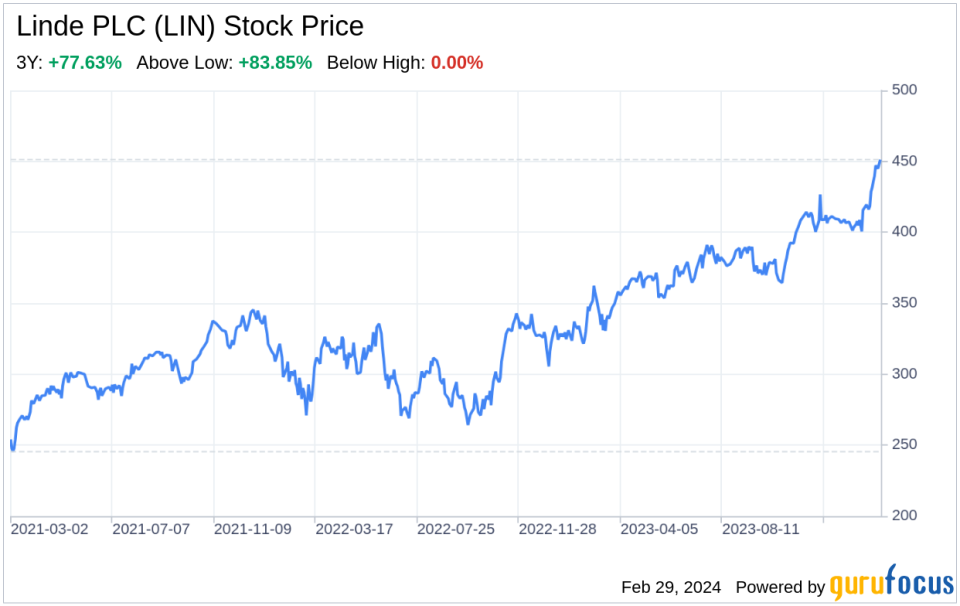Decoding Linde PLC (LIN): A Strategic SWOT Insight
Strengths: Dominant market position and technological innovation.
Weaknesses: High energy costs and dependence on raw material availability.
Opportunities: Expansion in emerging markets and advancements in applications technology.
Threats: Intense competition and regulatory changes.
On February 28, 2024, Linde PLC (NASDAQ:LIN), the world's leading industrial gas supplier, filed its 10-K report, revealing a robust financial performance with approximately $33 billion in revenue for the fiscal year 2023. This SWOT analysis delves into Linde's financial health and strategic positioning, drawing insights from the latest SEC filings to guide investors and stakeholders. Linde's financial tables indicate a strong balance sheet, with a significant market capitalization of approximately $186 billion as of June 30, 2023. The company's diverse product offerings and global footprint underscore its resilience and potential for sustained growth.

Strengths
Market Leadership and Brand Recognition: Linde PLC (NASDAQ:LIN) stands as the largest industrial gas company globally, a testament to its dominant market position. The "Linde" brand is a significant asset, symbolizing quality and reliability in the industrial gases sector. This brand strength is fortified by the company's extensive patent portfolio and technological prowess, which drive innovation and customer loyalty. Linde's competitive edge is further sharpened by its strategic pipeline networks, particularly in regions where these networks enable efficient and reliable product delivery to large customers.
Financial Robustness: Linde's financial performance reflects a strong balance sheet, with a market capitalization of $186 billion as of mid-2023. The company's revenue of approximately $33 billion in 2023 indicates a solid financial foundation, enabling strategic investments and shareholder returns. Linde's financial health is also supported by its ability to mitigate energy price fluctuations through contractual pricing formulas and surcharges, showcasing prudent financial management.
Weaknesses
Energy Cost Sensitivity: As the 10-K filing indicates, energy is the single largest cost in the production and distribution of Linde's industrial gases. While the company has mechanisms to manage price volatility, the unpredictability of energy prices poses a persistent risk. Fluctuations in electricity, natural gas, and diesel fuel costs can impact margins and necessitate adjustments in pricing strategies, potentially affecting competitiveness and profitability.
Raw Material Dependency: Linde's reliance on external sources for key raw materials such as carbon dioxide, helium, and hydrogen introduces vulnerability to market conditions. Although Linde has contracts and commitments ensuring the availability of most raw materials, long-term price stability and supply are uncertain, which could lead to operational and financial challenges.
Opportunities
Emerging Market Expansion: Linde's global presence positions it well to capitalize on growth opportunities in emerging markets. As economies in Asia, Africa, and South America continue to develop, demand for industrial gases for healthcare, manufacturing, and energy sectors is expected to rise. Linde's established brand and technological capabilities can be leveraged to capture a larger share of these burgeoning markets.
Technological Advancements: Linde's commitment to research and development is a catalyst for creating proprietary technologies that drive business growth. The company's innovation in application technologies opens avenues for new product offerings and services, particularly in environmentally focused markets where Linde can lead in sustainable solutions.
Threats
Competitive Landscape: The industrial gases market is highly competitive, with a mix of local, regional, and global players. Linde's 10-K filing acknowledges competitors like L'Air Liquide S.A. and Air Products and Chemicals, Inc., which exert significant competitive pressure. Linde must continuously innovate and optimize its operations to maintain its market leadership amidst this intense competition.
Regulatory Changes: Linde operates in a heavily regulated environment, with laws governing environmental protection, safety, and trade, among others. Changes in regulations, particularly concerning environmental protection and climate change, could necessitate substantial investments to comply, impacting Linde's financial results and market position.
In conclusion, Linde PLC (NASDAQ:LIN) exhibits a strong market presence and financial stability, underpinned by its brand recognition and technological innovation. However, the company must navigate the challenges of energy cost volatility and raw material dependencies. Opportunities for growth in emerging markets and through technological advancements present promising prospects. Nonetheless, Linde must remain vigilant in the face of fierce competition and evolving regulatory landscapes to sustain its industry leadership and drive future success.
This article, generated by GuruFocus, is designed to provide general insights and is not tailored financial advice. Our commentary is rooted in historical data and analyst projections, utilizing an impartial methodology, and is not intended to serve as specific investment guidance. It does not formulate a recommendation to purchase or divest any stock and does not consider individual investment objectives or financial circumstances. Our objective is to deliver long-term, fundamental data-driven analysis. Be aware that our analysis might not incorporate the most recent, price-sensitive company announcements or qualitative information. GuruFocus holds no position in the stocks mentioned herein.
This article first appeared on GuruFocus.
